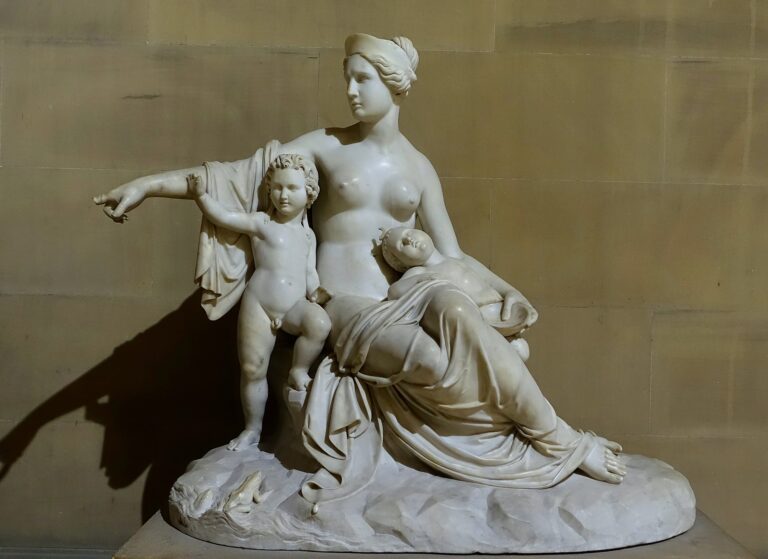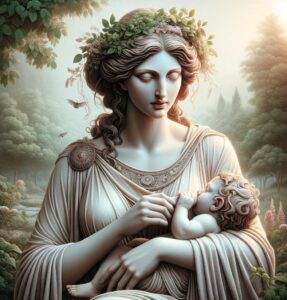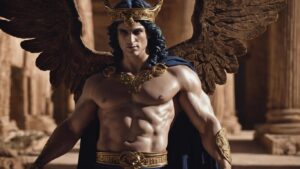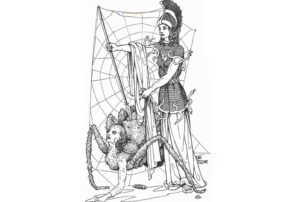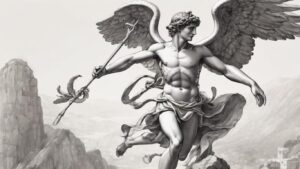Table of Contents
Leto, a figure shrouded in the annals of Greek mythology, emerges as a fascinating character. This detailed exploration delves into her origins, appearance, abilities, and the myths surrounding her, all within the framework of active voice and concise storytelling.
Origins and Family
Leto, a captivating figure in Greek mythology, has a rich background steeped in the lore of gods and Titans. Her story begins with her lineage, which is deeply rooted in the ancient Greek pantheon.
Parentage Leto is the daughter of the Titans Coeus and Phoebe. Coeus, known as the Titan of intelligence and inquisition, and Phoebe, the Titaness of prophecy and oracular intellect, are both members of the first generation of Titans. They are descendants of Uranus (Sky) and Gaia (Earth), primordial deities in Greek mythology. This lineage places Lēto among the most ancient and revered of the Greek mythological figures.
Siblings Lēto has notable siblings, each with their unique roles in the myths. Her sister, Asteria, personifies the starry night. Asteria’s own story is intriguing; she transformed into a quail and leaped into the sea to escape Zeus, eventually becoming the island of Delos. This island later becomes crucial in Lēto’s own story. Lēto’s brother, Lelantos, is less prominent but is associated with the air and the ability to move unseen, akin to a gentle breeze.
Early Significance In early Greek myths, Lēto’s role is somewhat overshadowed by her more prominent children, Apollo and Artemis. However, her importance cannot be understated. As a bridge between the generation of Titans and Olympian gods, she serves as a crucial link in the pantheon’s evolution.
Appearance
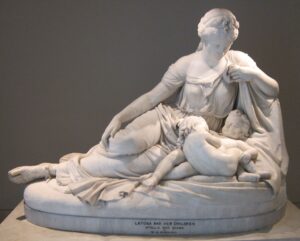
Leto, a figure from Greek mythology, holds primary recognition as the mother of the twin gods Apollo and Artemis, who play significant roles in Greek mythology. Although classical texts do not provide extensive descriptions of Leto’s appearance, they do offer some general characteristics and common artistic representations:
Leto is a serene and maternal figure in most depictions. Artists typically portray her as a gentle and nurturing mother, emphasizing her role as the mother of Apollo and Artemis.
Certain artistic representations depict Leto wearing a veil, which serves to symbolize modesty and motherhood and is a commonly associated attribute with maternal figures in various mythologies and cultures.
Variability in Portrayal: Like many deities in Greek mythology, Lēto’s appearance can vary across different artistic representations. Different artists and cultures may depict her in slightly different ways, but the common themes of serenity, motherhood, and modesty usually remain consistent.
Abilities
Leto’s abilities and attributes in Greek mythology revolve around her divine nature as a Titaness and her role as the mother of Apollo and Artemis. Here’s a closer look at her abilities:
Immortality: Like other Titans and deities in Greek mythology, Lēto is immortal. This means that she does not age, die, or experience the passage of time in the same way mortals do. Her immortality grants her eternal existence among the gods of Mount Olympus.
Lēto wields substantial influence and power, befitting her divine status. Although she isn’t renowned for feats of strength or magical abilities like some other Greek mythological deities, her power stems from her role as a mother and her connection to Apollo and Artemis. She occupies a revered position in the divine hierarchy as the mother of two prominent Olympian gods.
Maternal Role: Lēto’s primary attribute and source of her mythological significance is her role as a mother. Her enduring love and care for her children, Apollo and Artemis, are central to her character. As a mother, she represents maternal qualities such as nurturing, protection, and guidance. Her dedication to her divine offspring highlights the importance of family and motherhood in Greek mythology.
Resilience and Endurance: While Lēto may not be known for feats of strength or overt displays of power, her resilience and endurance are notable aspects of her character. She endured many challenges and hardships in her role as a mother, including the pursuit of her children by the vengeful goddess Hera. Lēto’s ability to overcome these challenges showcases her determination and strength of character.
Myths and Stories
One of the most famous myths associated with Lēto revolves around her children, Apollo and Artemis. These divine twins were born to Lēto and Zeus, which ignited the wrath of Hera, Zeus’s wife. Consumed by jealousy and vengefulness, Hera issued a decree forbidding Lēto from giving birth on “terra firma” or the mainland. This directive posed a significant challenge for Lēto, but she had no choice but to obey.
Undeterred by the threat from Hera, Lēto embarked on a perilous journey to find a suitable place to give birth to her children. Her quest led her to the floating island of Delos, where she ultimately delivered Apollo and Artemis.
Struggles and Persecution
Lēto’s journey to Delos was marked by numerous trials and tribulations. Throughout her journey, she found herself relentlessly pursued by Python, a fearsome serpent dispatched by the vengeful Hera. Despite the constant threat to her and her unborn children, Lēto displayed unwavering determination and resilience. Her actions exemplified the profound maternal instinct to protect her offspring at all costs.
Children: Apollo and Artemis
Apollo and Artemis, the offspring of Lēto, occupy a central role in her mythological narrative. These twin deities inherited and reflected many of Lēto’s own characteristics. Apollo, known as the god of music, arts, and healing, and Artemis, revered as the goddess of the hunt and chastity, embody the virtues of their mother. Myths featuring these divine siblings frequently emphasize their deep reverence and affection for Lēto, further underscoring her significance in their lives.
Cult and Worship
In ancient Greece, people held Lēto in veneration, especially in the sacred sanctuary of Delos. Although her cult did not attain the same prominence as that of her illustrious children, they respected and revered her as a maternal figure. Temples dedicated to Lēto, although fewer in number compared to those of Apollo and Artemis, served as tangible symbols of her divine status. Those who recognized her crucial role in the Greek pantheon and the enduring legacy of her maternal devotion conducted rituals and ceremonies in her honor.
Symbolism
Lēto, in Greek mythology, is linked to several symbols and attributes with significant meaning. She often wears a veil, symbolizing modesty, purity, and motherhood, highlighting her role as a protective and nurturing mother figure.
Lēto is sometimes depicted wearing a laurel wreath or crown, closely connecting this symbol to her children, Apollo and Artemis. Laurel wreaths signify victory and honor, emphasizing Lēto’s offspring’s achievements and divine status.
Another symbol linked to Leto is the palm tree, often seen in representations of her and associated with the island of Delos, where she gave birth to Apollo and Artemis. The palm tree symbolizes the location of their birth and the sanctuary dedicated to the twins on Delos.
Leto is sometimes connected to the cypress tree, associated with mourning and death in Greek mythology. This symbolism may reflect her connection to her children’s roles as gods associated with life and death.
Swans occasionally accompany Lēto, particularly in depictions of her journey to Delos. Swans helped guide her to the island, symbolizing grace, purity, and beauty, aligning with Lēto’s image as a serene and maternal figure.
Modern Interpretations
In contemporary culture, Lēto’s story is revisited for its symbolic value. Her tale resonates in discussions about motherhood, strength, and overcoming adversity. Modern adaptations sometimes reinterpret her story, keeping her legacy alive.
Lēto’s narrative, rich with themes of motherhood, resilience, and divine influence, offers a captivating glimpse into Greek mythology. Her journey, struggles, and the legacy of her children paint a picture of a revered Titaness. Despite the lack of elaborate depictions or tales of grandeur, her essence as a protective and enduring mother figure stands out. As a mythical figure, Lēto’s story continues to echo through time, reminding us of the enduring power and significance of maternal strength and resilience in the face of adversity.
FAQ
Who are Leto's children?
Leto's children are the twin gods, Apollo and Artemis.
What is Leto's role in Greek mythology?
Leto's role primarily revolves around her maternal connection to Apollo and Artemis.
Where is Leto's sacred sanctuary?
Leto's sacred sanctuary is located on the island of Delos in ancient Greece.
What symbols are associated with Leto?
Symbols associated with Leto include a veil, laurel wreaths, palm trees, cypress trees, and swans.
Is Leto considered an Olympian god?
No, Leto is not considered an Olympian god; she is a Titaness.
What is the significance of Leto's veil?
Leto's veil symbolizes modesty, purity, and motherhood, emphasizing her role as a nurturing mother figure.
Why is Leto associated with laurel wreaths?
Leto is associated with laurel wreaths because they symbolize victory and honor, reflecting her children's achievements.
What is the connection between Leto and the palm tree?
The palm tree is associated with Leto because it symbolizes the location of her children's birth on the island of Delos.
Why are swans linked to Leto?
Swans are linked to Leto as they are said to have guided her to Delos, symbolizing grace, purity, and beauty.
